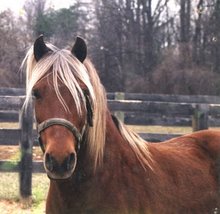If I've heard it once, I've heard it a thousand times: People mistakenly clump the two types of show horses together and believe that hunters and jumpers are one in the same. I'm sure there are many horses out there that can do both types of jumping, but that is my point: they are two totally different types of riding and are judged based on completely different criteria. Today we'll talk about show hunters. Tomorrow a description of the differences and what makes a good show jumper.
Show hunters are meant to simulate the vintage style of fox hunting, the "gentle person's" sport of the past when ladies rode sidesaddle in long flowing skirts, and men sipped brandy from miniature flasks that tucked neatly into their hunt coat pockets. There is a "politeness" that a judge will look for in a good show hunter, which includes the rider guiding the horse around a courtesy circle before beginning the course of obstacles, all of which should have a natural look to them.
In the ring, a show hunter should canter along at a pleasant pace ~ never rushing, but not sluggish, either ~ and should jump out of it's canter stride effortlessly. They are judged on a combination of things, which include "manners and way of going."
Manners means just that: the horse doesn't chomp at the bit, but rather accepts the riders aids and does as requested. They do not flick their tail, kick out in annoyance, or trot when asked to canter. They are interested in what they are doing, and show this by a keen expression with their ears forward, knees tucked neatly under their chest, and their eyes looking ahead to the next fence.
"Way of going" refers to the length of stride and the ease with which they go over the fences. They should have a touch of the pleasure horse in them, but with a little more spirit and athleticism required. There are five points of jumping an obstacle: Approach, take off, flight, landing, and getaway. The show hunter should leave the ground the same distance from the jump as he or she lands on the other side, and the highest point of the arc should be at the center of the jump. The horse should lift it's forelegs and tuck them squarely under his/her chest, and the topline should have a nice arc from the poll (the knobby spot between the ears on top of the head) to the tail, giving a gentle curved look, like the outline of a football (not sunken, flat or hollow).
A show hunter should never "suck back" when approaching a fence, but should move toward it at a steady, even pace. Neither should they wiggle from side to side, or rush after the landing. A polished show hunter will also switch leads without being asked at the proper place, but this is more often than not something an experienced rider will have to "suggest" at the appropriate time.
Tomorrow we'll delve into what makes a show jumper good, and the differences between the two.
Subscribe to:
Post Comments (Atom)

2 comments:
Hi there--
I am a dressage rider, interested in doing some hunter/jumpers in the winter months to keep my horse fit and interested. Is there a big difference between the seat of the rider in hunters vs. jumpers? The roundness of the horse? Are hunter's more long and low, jumpers more collected?
Thanks
Hi Katiemego,
Thanks for the inquiry. If you compare the seat of a dressage rider to the seat of a hunter or jumper rider, there are pretty significant differences. As you know, in dressage the rider sits deep in the saddle (so deep the horse should be able to feel the shifting of the rider's seat bones)with the legs long, almost to the point of being able to wrap around the horse and "hug" them with their legs.
A person riding a hunter will have a lighter seat overall, and many riders stay almost completely out of the saddle at the canter.
A jumper rider, while they use the half-seat position over fences, occasionally wants to have more contact with the horse, so they will sit in the saddle more often. For instance when the rider wants stronger communication with the horse, or to ask for more collection, to help the horse balance around corners, or to move forward on the approach to a fence. Both hunter and jumper riders have shorter stirrups than a dressage rider, which helps them stay up out of the saddle and get their weight down into the heels more effectively.
So really the short answer is, hunter and jumper riders will spend more time out of the saddle, but used in combination with a "dressage seat" for guidance, balance, and stronger communication with the horse.
A great resource for all kinds of information, such as the question you asked, is a book that is a companion to a riding students lesson, called "Making the Most of Your Riding Lessons" by Mike Smith. It is geared more toward riders who are just starting out, but another excellent resource is the United States Pony Club at http://www.ponyclub.org/.
All the best, and enjoy your ride!
Post a Comment